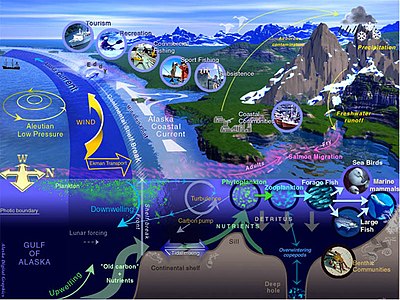This article contains too many pictures for its overall length. (December 2023) |
| Part of a series of overviews on |
| Marine life |
|---|
 |


Marine life, sea life or ocean life is the collective ecological communities that encompass all aquatic animals, plants, algae, fungi, protists, single-celled microorganisms and associated viruses living in the saline water of marine habitats, either the sea water of marginal seas and oceans, or the brackish water of coastal wetlands, lagoons, estuaries and inland seas. As of 2023[update], more than 242,000 marine species have been documented, and perhaps two million marine species are yet to be documented. An average of 2,332 new species per year are being described.[2][3] Marine life is studied scientifically in both marine biology and in biological oceanography.
By volume, oceans provide about 90% of the living space on Earth,[4] and served as the cradle of life and vital biotic sanctuaries throughout Earth's geological history. The earliest known life forms evolved as anaerobic prokaryotes (archaea and bacteria) in the Archean oceans around the deep sea hydrothermal vents, before photoautotrophs appeared and allowed the microbial mats to expand into shallow water marine environments. The Great Oxygenation Event of the early Proterozoic significantly altered the marine chemistry, which likely caused a widespread anaerobe extinction event but also led to the evolution of eukaryotes through symbiogenesis between surviving anaerobes and aerobes. Complex life eventually arose out of marine eukaryotes during the Neoproterozoic, and which culminated in a large evolutionary radiation event of mostly sessile macrofaunae known as the Avalon Explosion. This was followed in the early Phanerozoic by a more prominent radiation event known as the Cambrian Explosion, where actively moving eumetazoan became prevalent. These marine life also expanded into fresh waters, where fungi and green algae that were washed ashore onto riparian areas started to take hold later during the Ordivician before rapidly expanding inland during the Silurian and Devonian, paving the way for terrestrial ecosystems to develop.
Today, marine species range in size from the microscopic phytoplankton, which can be as small as 0.02–micrometres; to huge cetaceans like the blue whale, which can reach 33 m (108 ft) in length.[5][6] Marine microorganisms have been variously estimated as constituting about 70%[7] or about 90%[8][1] of the total marine biomass. Marine primary producers, mainly cyanobacteria and chloroplastic algae, produce oxygen and sequester carbon via photosynthesis, which generate enormous biomass and significantly influence the atmospheric chemistry. Migratory species, such as oceanodromous and anadromous fish, also create biomass and biological energy transfer between different regions of Earth, with many serving as keystone species of various ecosystems. At a fundamental level, marine life affects the nature of the planet, and in part, shape and protect shorelines, and some marine organisms (e.g. corals) even help create new land via accumulated reef-building.
Marine life can be roughly grouped into autotrophs and heterotrophs according to their roles within the food web: the former include photosynthetic and the much rarer chemosynthetic organisms (chemoautotrophs) that can convert inorganic molecules into organic compounds using energy from sunlight or exothermic oxidation, such as cyanobacteria, iron-oxidizing bacteria, algae (seaweeds and various microalgae) and seagrass; the latter include all the rest that must feed on other organisms to acquire nutrients and energy, which include animals, fungi, protists and non-photosynthetic microorganisms. Marine animals are further informally divided into marine vertebrates and marine invertebrates, both of which are polyphyletic groupings with the former including all saltwater fish, marine mammals, marine reptiles and seabirds, and the latter include all that are not considered vertebrates. Generally, marine vertebrates are much more nektonic and metabolically demanding of oxygen and nutrients, often suffering distress or even mass dyings (a.k.a. "fish kills") during anoxic events, while marine invertebrates are a lot more hypoxia-tolerant and exhibit a wide range of morphological and physiological modifications to survive in poorly oxygenated waters.
- ^ a b Cavicchioli R, Ripple WJ, Timmis KN, Azam F, Bakken LR, Baylis M, et al. (September 2019). "Scientists' warning to humanity: microorganisms and climate change". Nature Reviews. Microbiology. 17 (9): 569–586. doi:10.1038/s41579-019-0222-5. PMC 7136171. PMID 31213707.
 Modified text was copied from this source, which is available under a Creative Commons Attribution 4.0 International License.
Modified text was copied from this source, which is available under a Creative Commons Attribution 4.0 International License.
- ^ Drogin, B (2 August 2009). "Mapping an ocean of species". Los Angeles Times. Retrieved 18 August 2009.
- ^ Bouchet, Philippe; Decock, Wim; Lonneville, Britt; Vanhoorne, Bart; Vandepitte, Leen (June 2023). "Marine biodiversity discovery: the metrics of new species descriptions". Frontiers in Marine Science. 10 (3389). doi:10.3389/fmars.2023.929989 – via ResearchGate.
- ^ Cite error: The named reference
NOAA2019was invoked but never defined (see the help page). - ^ Paul, GS (2010). "The Evolution of Dinosaurs and their World". The Princeton Field Guide to Dinosaurs. Princeton: Princeton University Press. p. 19. ISBN 978-0-691-13720-9.
- ^ Bortolotti, Dan (2008). Wild blue: a natural history of the world's largest animal. New York: Thomas Dunn Books. ISBN 978-0-312-38387-9. OCLC 213451450.
- ^ Bar-On YM, Phillips R, Milo R (June 2018). "The biomass distribution on Earth". Proceedings of the National Academy of Sciences of the United States of America. 115 (25): 6506–6511. Bibcode:2018PNAS..115.6506B. doi:10.1073/pnas.1711842115. PMC 6016768. PMID 29784790.
- ^ "Census Of Marine Life". Smithsonian. 30 April 2018. Retrieved 29 October 2020.